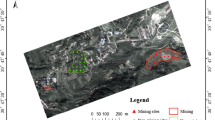Due to special mining technology, ionic rare earth mines easily change the surrounding surface soil properties and cause damage to the ecosystem, which leads to difficulties in vegetation ecological restoration. In this paper, tung trees, bamboo willow, and slash pine were selected as reclamation vegetation, and their spectral characteristics under ecological environmental stress were compared. In addition, by analyzing the correlation between their chlorophyll contents and spectral parameters, a theoretical basis for hyperspectral remote sensing for monitoring rare earth reclaimed vegetation growth is provided. The results show that the reflectance of the visible bands in the three vegetation types is less than 0.15, and there are different degrees of "redshifting" in the green peaks and red valleys; correlation analysis was carried out between the chlorophyll contents of the three vegetation types and the original spectra and derivative spectra. The optimal band in the original spectra was concentrated near the red valley. The first-order derivative spectra are more dispersed than the original spectra; the tung tree signal is concentrated in the red edge region, the slash pine signal is located in the near-infrared band, and the bamboo willow signal is located near the green peak and the red edge band. The three vegetation types have some of the same but also different chlorophyll-sensitive parameters. Among them, REP is the maximum parameter for the tung tree, Dr is the maximum parameter for slash pine, and SDr – SDb/SDb + SDr is the maximum parameter for bamboo willow, which can provide a reference for the construction of inversion models of different vegetation chlorophyll contents.
Similar content being viewed by others
References
L. Xia, Geograph. Geo-Inform. Sci., 26, No. 5, 37–40 (2010).
Hou Huifang, Qiao Xiaoying, Hao Ruijuan, and Guo Yiwei, J. Anhui Agric. Sci. Bull., 22, No. 11, 16–21 (2016).
Yanfang Ming, Lijuan Cheng, Huiyong Yu, and Wang Chunxiang, J. Ind. Soc. Remote Sens., 46, No. 1, 69–79 (2017).
Baodong Ma, Ao Xu, and Xuanxuan Zhang, IEEE Int. Geosci. Remote Sens. Symp. (IGARSS) 10–15 (2016).
Shichao Cui and Kefa Zhou, J. Earth Sci. Inform., 10, 169–181 (2016).
L. Xia, L. Shaofeng, and Z. Liquan, J. Sci. Surv. Mapping, 32, No. 2, 111–113 (2007).
G. Chaofan and Xiaoyu Guo, J. Acta Ecol. Sin., 36, No. 20, 6538–6546 (2016).
Shi Bingquan, Zhang Xiaoli, Bai Xueqi, and Zhang Xinxin, J. Northeast Forestry Univ., 43, No. 5, 80–83 (2015).
P. Bei, Z. Gengxing, Z. Xicun, Liu Haiteng, Liang Shuang, and Tian Dade, J. Spectrosc. Spectr. Anal., 33, No. 8, 2203–2206 (2013).
L. Qingsan, W. Chuanyi, T. Xiaolei, Xu Jialai, Yang Jutian, Liu Li, Zhu Xianzhi, Zhang Yuqin, and Xu Xiuhong, Southwest China J. Agric. Sci., 32, No. 2, 333–338 (2017).
D. Huaqiang, G. Hongli, F. Wenyi, Jin Wei, Zhou Yufeng, and Li Jin, J. Spectrosc. Spectr. Anal., 29, No. 11, 30–37 (2009).
G. L. Maire, C. François, and E. Dufrêne, J. Remote Sens. Environ., 89, No. 1, 1–28 (2004).
M. A. Cho and A. K. Skidmore, J. Remote Sens. Environ., 101, No. 2, 181–193 (2006).
G. Rondeaux, M. Steven, and F. Baret, J. Remote Sens. Environ., 55, No. 2, 95–107 (1996).
N. H. Broge and E. Leblanc, J. Remote Sens. Environ., 76, No. 2, 156–172 (2001).
D. A. Sims, J. A. Gamon, J. Remote Sens. Environ., 81, Nos. 2–3, 337–354 (2002).
Y. Fang, C. Donghua, L. Hu, Li Jiangui, and Xu Limin, J. Remote Sens. Inform., 31, No. 3, 88–93 (2016).
Yao Fuqi, Zhang Zhenhua, Yang Runya, Sun Jinwei, and Cui Sufang, J. Trans. CSAE, 25, No. 2, 123–129 (2009).
Author information
Authors and Affiliations
Corresponding author
Additional information
Abstract of article is published in Zhurnal Prikladnoi Spektroskopii, Vol. 87, No. 3, p. 508, May–June, 2020.
Rights and permissions
About this article
Cite this article
Li, H., Wei, Z., Wang, X. et al. Spectral Characteristics of Reclaimed Vegetation in a Rare Earth Mine and Analysis of its Correlation with the Chlorophyll Content. J Appl Spectrosc 87, 553–562 (2020). https://doi.org/10.1007/s10812-020-01038-7
Published:
Issue Date:
DOI: https://doi.org/10.1007/s10812-020-01038-7




